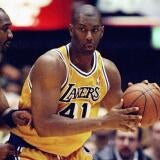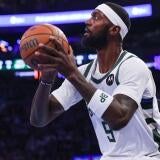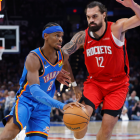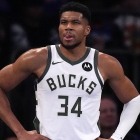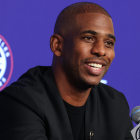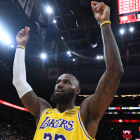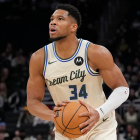That's Pretty Interesting: Reckoning with Giannis Antetokounmpo's dominant Bucks
Also in the notebook: A curiosity in OKC, the Sixers' pleasant surprise, weird times in Houston, and more
NEW YORK -- A confession: I find the Milwaukee Bucks exhausting. This is not because of their fast-paced style of play or their workmanlike attitude, but because of the way people talk about them. There are the loud voices, mostly online, scolding the media for not giving the Bucks enough respect. There are also the loud voices, mostly on television, speculating about Giannis Antetokounmpo leaving for a big market every time they say his name. All this noise is tiring, and it makes any discussion of their dominant regular-season fraught.
My takes about the Bucks are lukewarm at best: No team has been as consistently great this season, and their best-in-NBA-history net rating challenges my opinion that they should have paid Malcolm Brogdon last summer. They're also not flawless, and they haven't necessarily patched up the holes that appeared in last year's conference finals.
At its worst, Milwaukee's halfcourt offense is stagnant and predictable. As its 39-6 record indicates, it has not been at its worst very often. Aside from a handful of games, including the Christmas Day debacle in Philadelphia, a close loss in Utah and a surprisingly ugly evening in San Antonio, the Bucks have overcome their cold stretches.
They have the most efficient halfcourt offense in the league, according to Cleaning The Glass. Maybe they've figured everything out. Maybe this is a perfect mix of coach Mike Budenholzer's movement-oriented system from his Atlanta Hawks days and the simple and elegant surround-Antetokounmpo-with-shooters approach. Maybe I shouldn't be reluctant to say they're on their way to a championship.
On Sunday at Barclays Center, I watched the Bucks dispose of the Brooklyn Nets the way they have so many other opponents. The final score was 117-97, and Antetokounmpo only needed to play 25 minutes to score 29 points. After the game, I sought out Kyle Korver, the only Buck who can compare this offense to the beautiful, free-flowing one that allowed five Hawks to share player of the month honors five years ago.
"There's some similarities in that we want to play fast, we play uptempo, try to play in space," Korver said. "Giannis changes the game and there's no way around that. I think in Atlanta we relied on the offense and the moving parts and everything working together to create our best product. And now, Giannis, we want to take advantage of his strengths. Because he's so good, he's so great, things have shifted a good bit to take advantage of his skillset. Because that's what should be happening."
And when Antetokounmpo is on the bench?
"Maybe it looks a little bit more like what we used to do in Atlanta," Korver said. "When he's off the court, we have to take advantage of what we have. I feel like we're trying to find that nice, healthy balance."
Is it possible, even though the system is Giannis-centric, to feel the same sort of flow as those Hawks did when everybody was involved and in sync?
Korver hesitated. "It's different now," he said. "I think we've found -- I mean we're still, I don't know what we rank in offense, we've found good rhythm, we've found good ways to score the basketball, to get guys involved. It's definitely still a little different, you know? It doesn't make one thing better than the other, right? Often it's easy to say this is better than that, I like this, I don't like this.
"They've both been very effective, and I think we're just trying to maximize (our talent). The mark of a great coach is not just like this is how I play and you're going to do what I do best instead of what are my pieces, what are their strengths, how do I play to their strengths? And so I think that's what coach Bud has brought here: My strengths are different than my strengths were in Atlanta. And so things have shifted a little bit."
Every team has to balance structure and improvisation. The best ones generate good looks through individual playmaking and through ball and player movement. How does that work in Milwaukee?
"I think that's what we continue to work for," Korver said. "I think our offense is going to keep getting better. But you play to your strengths. But certainly you have to be able to counter whatever the defense is doing. That's what the regular season is for. And I think we're on a good path with all that."
After talking to Korver, I felt just as uncertain as before. But what did I expect he would say? Playing with Antetokounpo can't possibly feel the same as playing in an equal-opportunity system designed to make up for a lack of star power. If the Bucks' big-picture goals can't be accomplished until June, why would anyone on the team boast about their success in January?
It feels meaningful that Milwaukee's offense has been so efficient. To me, it also feels premature to assume that it will adjust as well as it needs to against elite defense, under playoff pressure. Maybe that is OK: Certainty is boring, and the beauty of the postseason is that there's nothing like it.
In a way, then, the Korver conversation was clarifying. The Bucks have been excellent, but they are not getting ahead of themselves. And neither should we.
A curiosity in OKC
If you just looked at his stats, you'd think Oklahoma City Thunder forward Darius Bazley would be easy to miss. The rookie has a usage rate of 13.7 percent, a number comparable to that of former Thunder luminary Thabo Sefolosha, the defender aptly described in Sam Anderson's "Boom Town" as "a buffer in the offense between (Russell) Westbrook and (Kevin) Durant, a small absence between two massive presences, a little zone of silence between two walls of noise."
In 18 of the 44 games he has played in the NBA, Bazley has attempted three shots or fewer. Last week in Minnesota, he played 16 minutes and didn't take a single shot. But when you watch Oklahoma City, it's impossible not to notice him.
Bazley is upside personified. At 6-foot-9 with a 7-foot wingspan, he is the quintessential Thunder project. He moves fluidly and handles the ball like someone much shorter, bringing to mind fellow lefties Lamar Odom and Anthony Randolph, depending on how generous you're feeling. If you catch him at the right moment, you might see something spectacular:
Opponents, however, are generally content to ignore Bazley on the perimeter, as he is shooting 30.7 percent from deep. And while he has held down a spot in the rotation and started seven games, his potential is much more compelling than his early production: He is averaging 4.3 points and 3.8 rebounds in 17.2 minutes, with 45.6 percent true shooting.
"As a rookie and being 19 years old, he doesn't do anything, like, great," Oklahoma City coach Billy Donovan said. "He does everything really well. But I think the more experience he gets, he'll start to kind of shape out and form out into who he's going to be. But he's got a lot of skills that he can rely upon."
Growing up, Bazley's three favorite players were Penny Hardaway, Magic Johnson and Durant. Given that he was born in 2000, watching the first two required him to find highlights on YouTube and NBA Hardwood Classics on TV. It is not a coincidence that he gravitated toward tall, creative types.
"Those guys, being that tall and being able to do what they can with the basketball -- whether it's pass, shoot, dribble, you know what I'm saying? -- I always liked to have those attributes to my game," Bazley said. "So watching them was just kind of cool."
Donovan didn't exactly call Bazley a blank canvas, but it was implied. The coach praised his feel for the game and his defensive versatility and expressed confidence that he'd improve as a shooter.
"I think he's really open to being coached and listening and growing and getting better," Donovan said. "Like most rookies, there's going to be ups and downs."
Bazley is a reluctant shooter, but his form isn't bad or broken. He needs to keep adding strength and stop biting on pump fakes, but as a defender, he surprises opponents with his length and quickness:
His athleticism shows up in transition:
And while he is a bit turnover-prone when he puts the ball on the floor, his feel comes through with his passing:
The biggest thing he's working on, Bazley said, is simply making the right plays: Driving and kicking, knowing when to make the extra pass, screening technique. "This is my first time for everything," he said. Bazley decommitted from Syracuse at 17, then canceled plans to play in the G League, instead spending the 2018-19 season preparing for the draft. Now he has coaches watching film with him and Chris Paul approaching him with advice.
Bazley is not one of Oklahoma City's best players, nor is he necessarily the future of the franchise. (That's Shai Gilgeous-Alexander.) No one on the roster, though, embodies the state of the team better than this skinny, versatile teenager. Bazley's game could go anywhere in the next few years, just like the Thunder.
Merry Korkmaz
This time last season, Furkan Korkmaz's spot in the Philadelphia 76ers' rotation was tenuous at best. He had requested a trade before the start of the season, and Philadelphia had declined to pick up the third-year option on his rookie contract.
The 2018-19 Sixers made three major in-season trades, but none involved Korkmaz. Against all odds, he re-signed with Philadelphia on a two-year minimum contract in late July, and coach Brett Brown can hardly believe how important he has become to the team.
"He's assumed an incredibly unlikely role," Brown said.
Last Friday against the Chicago Bulls, Brown subbed him in with a three-point lead midway through the third quarter. In a less-than-two-minute stretch, Korkmaz made a 3-pointer on four straight possessions, completely breaking the game open. He finished with a career-high 24 points on 8-for-11 shooting, making six of his nine 3-point attempts.
On Sunday against the Brooklyn Nets, Korkmaz ran a pick-and-roll with Al Horford on a crunch-time possession. After some ball movement, Korkmaz nailed a one-dribble 3, essentially securing the win:
That was not even his most clutch shot of the season: In November, he hit a game-winning corner 3 off the catch, stunning the crowd in Portland.
"He's almost become one of our go-to guys at times, getting playcalls," Brown said. "I'm clawing back some of JJ Redick's playcalls and giving them to him. And those weren't really used with anybody else on the team. We don't really have anybody that's sort of like Furkan or JJ used to be."
Korkmaz has become a crucial source of spacing and scoring for the Sixers, especially with Joel Embiid sidelined. In Philadelphia's last four games, he has averaged 16.5 points in 23.3 minutes and shot 15-for-30 from deep.
On the season, Korkmaz has made 43.2 percent of his catch-and-shoot 3s. No Sixer shoots 3s as frequently or with a quicker release:
"I mean, he's just been great," Brown said. "And I think that you all sort of see him making shots; what I see is an improved defender and I also see somebody that is more than capable in a pick-and-roll."
Korkmaz's pick-and-rolls haven't been particularly efficient, but it is notable that Brown is letting him run them at all, let alone talking him up. Philadelphia can use all the playmaking it can get, and Korkmaz has indeed showed some flashes.
Like this bounce pass to Ben Simmons …
and this ridiculous floater over Luke Kornet …
and these nifty finger rolls:
I am not about to call Korkmaz the new Redick, nor do I see him being the halfcourt creator the Sixers will need in the playoffs. His confidence keeps growing, though, and he didn't even need to leave Philadelphia to find it.
Russ and the Rockets
Well, this is weird: Russell Westbrook's best individual stretch of the season has coincided with the Houston Rockets collectively stinking it up. In his last five games, four of them losses, Westbrook has averaged 32.4 points and 9.2 assists while shooting 55.9 percent. (Westbrook missed Houston's 121-110 loss to the Memphis Grizzlies last Tuesday.)
Westbrook is still bricking lots of 3s -- including an ill-advised off-the-dribble attempt in the corner late in the Rockets' fourth-quarter collapse against his former team on Monday -- but opponents have had trouble keeping him out of the paint. He has made more of his in-between shots, too. Unfortunately for Houston, James Harden has shot poorly and the defense has reverted to its early-season form.
Harden shot 1-for-17 from deep on Monday and the Rockets squandered a 15-point lead in the final seven minutes. Forward Danuel House said they are in a "dark cloud," while coach Mike D'Antoni described it as a "funk," via ESPN's Tim MacMahon. "Now, it's like, if we're going to walk under a window, a piano is going to fall out," D'Antoni said.
From a broad perspective, Houston has made some progress. It is no longer caught off-guard by aggressive traps against Harden. It has been average on defense, not awful, for most of the season. This whole Harden-Westbrook experiment feels wobbly, though, and the Rockets will need both playing at a high level -- and, ideally, a top-10 defense -- come playoff time.
Pow!
If I were to tell you that a Toronto Raptor averaged 23.6 points on 59/53/94 splits in the last five games, how many guesses would it take before you land on Norman Powell?
The reserve guard scored 15 points in three minutes and two seconds in the fourth quarter of Toronto's 122-117 win in Atlanta on Monday, finishing with 27 points and shooting 6-for-9 from deep. Powell was having a career season before his shoulder injury, but I didn't expect him to come back from it shooting like Klay Thompson.
A reminder: Two seasons ago, Powell shot 28.5 percent from deep, bounced in and out of the rotation and opponents regularly dared him to shoot.


